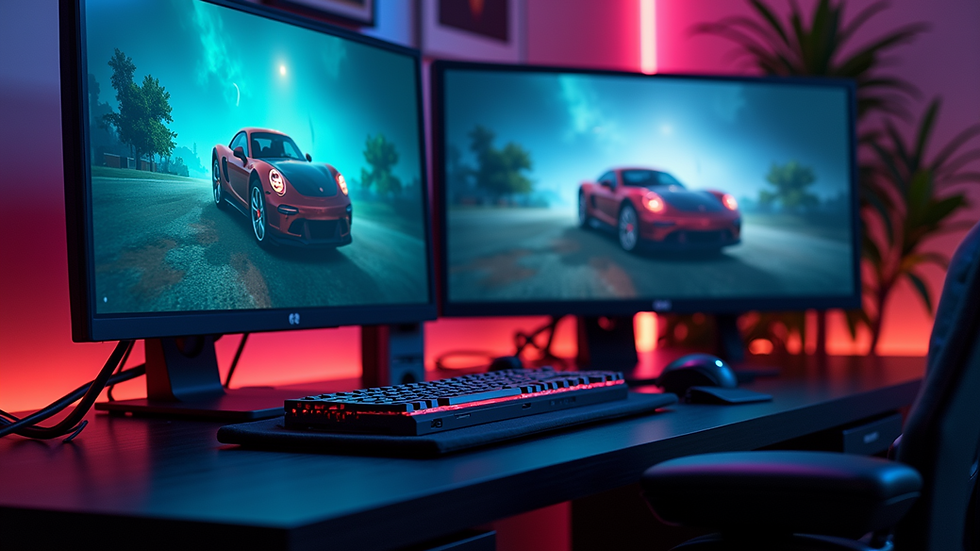The Evolution of Graphics Cards: From Past to Present
- Computer Citi
- Aug 14
- 4 min read
The world of graphics cards has seen a remarkable transformation since they first appeared. What started as simple 2D rendering has evolved into the stunning 3D graphics we enjoy today. This journey through history reflects not only advancements in technology but also the increasing demands of users. In this blog post, we will explore the history of graphics cards, the defining trends in their development, and predictions for a future filled with innovation.
The Early Days: 2D Graphics
In the late 1970s and early 1980s, graphics cards focused primarily on 2D rendering. The first graphics cards, like the IBM CGA (Color Graphics Adapter) and EGA (Enhanced Graphics Adapter), were basic. They offered limited graphics capabilities, mainly supporting simple tasks like displaying text and geometric shapes. For example, the CGA only supported a 320x200 resolution and four colors.
The introduction of the VGA (Video Graphics Array) in 1987 was a game-changer. With a resolution of 640x480 pixels and support for 256 colors, VGA allowed for more detailed graphics. This development paved the way for the more advanced graphics cards that would follow and laid the foundation for modern graphics technology.
The Rise of 3D Graphics
The 1990s marked a significant change in the graphics world with the rise of 3D graphics. As video games gained popularity, the demand for improved graphics performance skyrocketed. Companies like 3dfx Interactive and NVIDIA began introducing dedicated 3D graphics cards.
One notable example is the Voodoo Graphics card, launched by 3dfx in 1996. It was revolutionary for its time, enabling real-time 3D rendering. This advancement allowed developers to create immersive gaming experiences, such as the popular “Quake” game, which showcased the card's abilities. The introduction of 3D graphics fueled a competitive market, leading to rapid innovations.
The Era of GPUs
As the need for greater graphics processing power grew, so did the development of graphics processing units (GPUs). In the early 2000s, NVIDIA launched the GeForce series, featuring programmable shaders and support for DirectX 8. With these enhancements, developers could produce more realistic graphics and complex visual effects. For instance, games like "Halo: Combat Evolved" utilized these advancements, making the graphics truly stand out.
AMD did not stay idle either; their Radeon series entered the market, resulting in fierce competition. The evolution of GPUs transformed graphics cards into powerful components designed specifically for rendering graphics. This specialization allowed CPUs to allocate resources for other tasks, improving overall system performance.
The Modern Graphics Card
Today’s graphics cards are incredibly powerful and versatile. They are not only utilized for gaming but also for applications like video editing, 3D modeling, and even artificial intelligence tasks. One of the key advancements is ray tracing technology, which produces highly realistic lighting and shadow effects. For example, games like "Cyberpunk 2077" have pushed the boundaries of graphical fidelity with this new standard.
Modern GPUs, such as NVIDIA's RTX series and AMD's Radeon RX series, feature advanced architectures. These cards support real-time ray tracing and AI-driven graphics enhancements, achieving unprecedented levels of detail. In fact, reports show that gamers using ray tracing can experience a 50% increase in visual realism compared to non-ray tracing environments.

Trends Shaping the Future
Looking forward, several trends are influencing the evolution of graphics cards. A major trend is the increasing demand for high-resolution displays. With 4K and 8K gaming on the rise, the need for powerful graphics cards to support such resolutions is clear. Statistics indicate that the market for 4K gaming will exceed $160 billion by 2025, emphasizing the urgency for continued advancements in graphics technology.
Another noteworthy trend is the growing popularity of cloud gaming. Services like NVIDIA GeForce NOW and Google Stadia allow users to stream games instead of relying purely on high-end hardware. This shift puts pressure on graphics card manufacturers to create more efficient and compatible designs. As cloud gaming continues to gain traction, traditional high-performance specs may take a back seat to efficiency and user experience.
The Impact of AI and Machine Learning
Artificial intelligence and machine learning are set to play a key role in the future of graphics cards. Companies are integrating AI capabilities into graphics processing, allowing for features like DLSS (Deep Learning Super Sampling). This technology enhances performance significantly, claiming up to a 30% increase in frame rates while maintaining visual quality.
As AI becomes more powerful, graphics cards are expected to evolve into even smarter devices. They could optimize performance based on gaming habits and user preferences, leading to a more personalized gaming experience.
Final Thoughts
The evolution of graphics cards has been an exciting journey marked by groundbreaking advancements. From the limited 2D graphics of the early days to today’s sophisticated GPUs, graphics cards have revolutionized our digital experiences.
Moving forward, trends such as AI integration and the rise of cloud gaming will continue to impact the industry. As demands for higher resolutions and enhanced performance grow, we can expect the next generation of graphics cards to deliver even more immersive and realistic experiences. The future certainly looks bright for graphics technology, and we can't wait to see what new innovations are on the horizon.









Comments